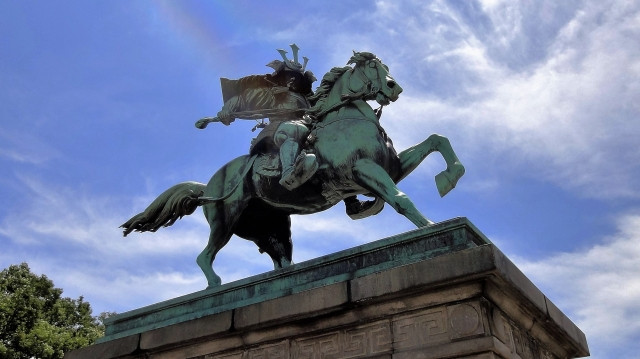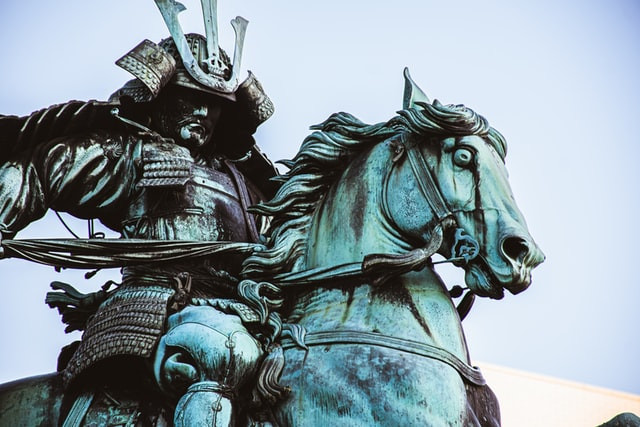Kamakura is a significant era in Japanese history. Defining moments during that period include the establishment of a warrior caste system, the emergence of the samurai, and feudalism as the primary form of government in Japan. Other significant occurrences are the development in Japanese Art like paintings and metalworks.
Table of Contents
- Brief Introduction to the Kamakura Period
- Significant Events during the Kamakura Period
- Kamakura Art Developments
- In Conclusion
Brief Introduction to the Kamakura Period
The Kamakura Period, a very important era in Japan, spanned 141 years from 1192 to 1333. The era came to be when Yoritomo of the Minamoto Clan was triumphant in the battle of Dannoura against the Taira clan. Yoritomo established himself as the first Shogun of Japan in the coastal town of Kamakura in Kanagawa, thus was the name of the era created.
※ World History Encyclopedia, "Kamakura Period" ※ Encyclopædia Britannica, Inc., "Kamakura Period”
Significant People

Minamoto Yoritomo is probably one of the most famous figures during the Kamakura Period. He was the founder of the Bakufu, or the shogunate in Japan. It was during this period that the rise of the feudal lords started and feudalism in Japan flourished.
Yoritomo was said to be a formidable man. He has a royal lineage and a military background because of his family’s experience with war. Because of this, his military knowledge and prowess became very evident during his rule (1192 until 1199). It was also said that he was not a fan of the court culture where people had to tiptoe around royalty and had all the rules and etiquette surrounding the imperial family. He was a straightforward person, even called ruthless (partly because he killed his brothers and cousins to rise to power). Needless to say, his rule was dominated by military personnel which changed the course of Japan’s history.
※ Encyclopædia Britannica, Inc., "Minamoto Yoritomo"

The Hojo Regents rose to power after Yoritomo passed away. Even though the Hojo regents were considered a minority group in Japan, they were the ones who had the ability to control the country and largely influenced the military activity, political, and even the economic state of the country. They ruled Japan from the early 1200s to the early 1330s. Both the shoguns and the imperial family in Kyoto were symbolic and were considered dummy emperors.
※ Encyclopædia Britannica, Inc., "Hōjō Family"
Emperor Go-Daigo is another important historical figure during the Kamakura Period. He was the emperor who successfully defeated the Hojo Regents. As a result, the imperial family rose to succession with the emperor in power once more, called the Kenmu Restoration. He ruled from the late 1310s to the late 1330s but unfortunately it didn’t last long due to his failure to reward those that helped him to power.
※ Encyclopædia Britannica, Inc., "Go-Daigo"
Shogunate and Hōjō Regency
As demonstrated above, this period was marked by the power struggle between the Shogunate and the Hojo Regents. The Shogunate regency is a popular modern term for the bakufu. Military power headed by Minamoto Yoritomo largely influenced the Shogunate regency. Though it was not a formal regime (as technically the role of emperor still existed), the regents controlled the majority of the country’s power, including amassing hectares of land. The Shogunate regency mainly consisted of an administrative board, a board of retainers, and a board of inquiry. Aside from having political power and influence over the country, they also controlled military activity.
The Hojo regency started to form official ties with the Yoritomo Clan through marriage and political support. However, when Yoritomo died, the Hojo Regency was strategic enough to claim the throne, which started their rise to power. During this time, the imperial family lost all control and power of the country and just became puppets. Because of changes and instability, this was also the period that Japanese culture, as reflected by art and literature, became very bleak. One example is the Heike Monogatari that narrated the rise and fall of the Taira.
Writer's Pick
Significant Events during the Kamakura Period
The Kamakura Period is an era marked by rapid change and instability. This era was marked with unrest and violence. Here are other significant events that were prominent during the Kamakura Period.
Emergence of the Samurai

The focus on military governance brought about the emergence of a warrior caste system and samurai. Samurai warriors became important and revered figures in society, tasked with the responsibility of protecting the country and its leaders. During Yoritomo’s reign, only warriors he deemed worthy were allowed to call themselves samurai.
If you are curious and want to experience being a samurai yourself, there are many areas in Japan that teach you the ways of the Samurai. This includes the Samurai and Ninja Interactive Museum and Show in Kyoto, among others!
※ Encyclopædia Britannica, Inc., "Samurai" ※ History, "Samurai and Bushido"
Warrior Caste System

Bushido is the code of conduct of a samurai. It is a code of moral conduct and values that each samurai should uphold throughout their life and even in death, these include loyalty, bravery and honour above one's own life. It is an honour to a samurai to lose one’s life in service to the country.
Additionally, this belief also lies at the heart of ritual suicide seppuku 切腹. Also known as harakiri 腹切り (literally to cut your stomach), seppuku is performed on 2 occasions:
-
Show of loyalty
-
Capital punishment
The former is done by cutting into the left side of the stomach with a small sword, slicing to the right, then turning the blade up. Seppuku is the utmost act of loyalty, honour and bravery for a samurai warrior, especially if it means following one’s master into death or to choose to die rather than surrendering.
※ ThoughtCo., "Bushido: The Ancient Code of the Samurai Warrior"
Feudalism in Japan
Feudalism in Japan includes the rise of power of the military and the decline of power by the Imperial family. Here, those in power imposed strict rules and regulations, including the tax system, controlling religion in the country, and having militarized systems in place. They were also able to amass large amounts of wealth and lands.
※ World History Encyclopedia, "Feudalism in Medieval Japan"
Failed Mongol Invasions
In one of the most fascinating natural phenomenons during this period and perhaps in Japanese history, Japan was able to ward off two Mongol invasions, not by military prowess but because of the monsoons that wiped out the invaders’ fleets both times. This is always mentioned in regards to the Kamakura Period, because of how astonishing this is, and how differently history may have played out had the invasions been successful or at least dealt a bigger blow to the Kamakura shogunate.
Kamakura Art Developments
With the constant changes during the Kamakura Era, and especially the feudal system, expectedly unrest and fear grew amongst the people. These emotions were translated into art.
For more about Japanese Art, check
From Paintings to Pottery, Exploring Traditional Japanese Art
Painting Developments

Buddhism kicked off during the Kamakura period, especially Zen Buddhism amongst the samurai. Unsurprisingly, religious sculptures and paintings grew in number. Sumi-e (ink painting) depicting historical moments and landscapes carrying heavy spiritual connotations were also popular at this time. Despite the onslaught of religion-related art pieces, secular paintings did not lag in development with human portraits becoming more elaborate and realistic in style.
Important Sculptures

Likewise, religion was a heavy influence on sculptures with many Buddha and Konnan sculptures built in this era. This includes the Kamakura Buddha in Kotoku-In that went on to be designated as a UNESCO World Heritage. For more about it, check Kamakura
Buddha, The Symbol of Kanagawa.
The Kongo Rikishi guardian statues at Todaiji’s Great South Gate are also heavily influenced by Kamakura Realism style. For more about it, check Todai-ji, A Mighty Temple and Landmark of Nara.
Important Metalworks
Metalworks also became very popular during the Kamakura Period, largely because they were used in Buddhist ceremonies. These metalworks include bells, reliquaries, and other ritual items. You can find some of them in local museums, like the Tokyo National Museum, while others were exported and displayed abroad such as in the Harvard Museum and the Asian Art Museum of San Francisco.
※ Encyclopedia Britannica, “Japanese Art”
In Conclusion

The Kamakura Period was a period of change and instability in Japan. The rise of military power influenced a lot of Japan’s culture which is reflected during art and literature during this period. Understanding this important milestone in Japanese history can help you appreciate the culture when you visit Japan, especially Kamakura.
For more about Japan’s Medieval Period, which the Kamakura Period kicked off, check:
A Brief Look into History: Japan During the Medieval Period



































